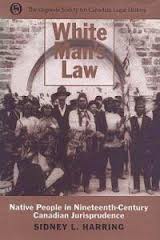Dr. Sidney Harring is Professor Emeritus at the City University of New York School of Law. Besides teaching undergraduate sociology and law, he has done extensive research and scholarship on juries, police, American Indians, and the social history of American law. These wide-ranging interests have taken him around the world; he has been a visiting scholar in India and Australia, and a visiting professor in Namibia, Canada, Malaysia, and Russia. He also served as Visiting Professor of Law at West Virginia University College of Law in 2001. The author of more than 80 articles, chapters, and book reviews on such subjects as American and British colonial history, Native American law, indigenous rights, and criminal law, he has written four books, the third of which, White Man’s Law: Native People in Nineteenth Century Canadian Jurisprudence, published by the Osgoode Society, was a finalist for the Donner Prize as the best book on Canadian public policy published in 1998.
During the course of his career, he has received three Fellowships in Legal History from the National Endowment for the Humanities, a Fulbright Fellowship, and was a Rockefeller Fellow at the McNickle Center for the History of the American Indian. Dr. Harring was also the holder of the Law Foundation of Saskatchewan Endowment Chair from July 1994 to June 1995. He has also been awarded numerous research grants to study issues of criminal justice, Native Americans in the U.S. and Canada, and legal issues facing Australian Aborigines and Namibians.
He can be reached at harring@mail.law.cuny.edu
Osgoode Society for Canadian Legal History Books
White Man’s Law: Native People in Nineteenth Century Canadian Jurisprudence (Toronto: The Osgoode Society and University of Toronto Press, 1998), 434 pp.
Other Legal History Publications
‘The Attica Trials’ in Frankie Y. Bailey and Steven M. Chermak (eds.), Famous American Crimes and Trials 4, 1960-1980 (Westport, Conn.: Praeger, 2004), pp. 159-172.
‘Communal Lands, Land Reform, and “Indigenous” Peoples’ Right to Land in Namibia’ in Land in Southern Africa (Copenhagen: International Working Group for Indigenous Rights, 2004).
‘There Seemed To Be No Recognized Law: Canadian Law and the Plains Indian Nations’ in Louis Knafla & Jonathan Swainger, eds., Law for the Buffalo, Law for the Musk Ox: Studies in the Legal History of the Canadian North-West Territories and Prairie Provinces, 1670-1945 (Toronto: University of Toronto Press, 2003), pp.
‘The Wendigo Killings: The Legal Penetration of Canadian Law into the Spirit World of the Ojibway and Cree Indians’ Criminal Justice History, Vol 19, 2003, pp. ??
‘German Reparations to the Herero Nation: An Assertion of Herero Nationhood in the Path of Namibian Development’ West Virginia Law Review, Vol 104, 2002, pp. 393-417
‘”An Indian Cannot Get a Morsel of Pork…” A Retrospective on Crow Dog, Lone Wolf, Blackbird, Tribal Sovereignty, Indian Land and Writing Indian Legal History’ Tulsa Law Review, Vol 38, 2002, pp. 87-111 (with Anthony G. Gulig).
‘Indian Law, Sovereignty, and State Law: Native People and the Law’ in Neal Salisbury and Philip Deloria, eds., A Companion to American Indian History (Malden, Mass., USA; Oxford, UK: Blackwell, 2001), pp. 441-459.
‘The Defendant has Seemed to Live a Charmed Life: Hopt v. Utah: Territorial Justice, The United States Supreme Court and Late Nineteenth Century Death Penalty Jurisprudence’ Journal of Supreme Court History, Vol 25, 2000, pp. 40-71 (with Kathryn Swedlow).
‘The Six Nations in Upper Canadian Legal History: Canadian Law and the Struggle for Tribal Sovereignty, 1784-1860’ in David T. McNab, ed., Earth, Water, Air, and Fire: Studies in Canadian Ethnohistory (Waterloo: Wilfrid Laurier University Press, 1998), pp. 181-231.
Crow Dog’s Case: American Indian Sovereignty, Tribal Law, and American Law in the Nineteenth Century (Cambridge; New York: Cambridge University Press, 1994), 301 pp.
‘Killing Time: A Legal History of Aboriginal Resistance in Colonial Australia’ Ottawa Law Review, Vol 26, 1994, pp. 385-423.
‘The Liberal Treatment of Indians: Native People in Nineteenth Century Ontario Law’ Saskatchewan Law Review, Vol 56, 1993, pp. 297-371.
‘Red Lilac of the Cayugas: Indians, Indian Law, and Culture Conflict in a Witchcraft Trial in Buffalo, N. Y., 1931’ New York History, Vol 73, 1992, pp. 65-114. Reprinted in Elizabeth Reis, ed., Spellbound: Women and Witchcraft in America (New York: Rowman & Littlefield, 1998) pp. 183-201; Frederick Hoxie et.al., eds., American Nations: Encounters with Indian Country, 1850 to the Present (New York: Routledge, 2001) pp. 221-241; and Brian Levack, ed., New Perspectives on Witchcraft, Magic, and Demonology (New York, Routledge, 2001), pp. ??
‘Tlingit Sovereignty Under United States Rule’ in Henry Reynolds and Richard Nile, eds., Indigenous Rights in the Pacific and North America: Race and Nation in the Late Twentieth Century (London: University of London and Sir Robert Menzies Centre for Australian Studies, 1992), pp. //
‘Please Send Six Copies of the Penal Code: British Colonial Law in Selangor, 1874-1880’ International Journal of the Sociology of Law, Vol 19, 1991, pp.
‘Crazy Snake and the Creek Struggle for Sovereignty: The Emergence of a Creek Legal Culture’ American Journal of Legal History, Vol 34, 1990, pp. 365-380.
‘The Rich Men of the Country: Canadian Law in the Land of the Copper Inuit, 1914-1930’ Ottawa Law Review, Vol 21, 1989, pp. 1-64
‘Crow Dog’s Case: A Chapter in the Legal History of Tribal Sovereignty’ American Indian Law Review, Vol 14, 1989, pp. 191-239.
‘Incorporation of Alaskan Natives Under American Law: The United States and Tlingit Sovereignty, 1867-1900’ Arizona Law Review, Vol 31, 1989, pp. 279-327.
‘Car Wars: Strikes, Arbitration, and Class Struggle in the Making of Labor Law’ New York University Review of Law & Social Change, Vol 14, 1986, pp. 849-872.
‘Lumber, Law, and Social Change: The Legal History of Willard Hurst’ American Bar Foundation Research Journal, Vol 1985, 1985, pp. 123-137 (with Barry Strutt).
Policing a Class Society: The Experience of American Cities, 1865-1915 (New Brunswick; New Jersey: Rutgers University Press, 1983), pp.
‘Policing a Class Society: Late 19th and Early 20th Century Expansion of the American Municipal Police’ in David Greenberg, ed., Crime and Class: Essays in Criminology (1980)
‘Class Conflict and the Enforcement of the Tramp Acts in Buffalo During the Depression of 1893-94’ Law and Society Review, Vol 11, 1977, pp. 873-912.
‘Police Reports as Sources in Labor History’ Labor History, Vol 18, 1977, pp. 585-591.
‘The Development of the Police Institution in the United States’ Crime and Social Justice Journal, Number 5, 1976, pp. 54-59.
‘The Buffalo Police: Labor Unrest, Political Power, and the Creation of the Police Institution’ Crime and Social Justice Journal, Number 4, 1975, pp. 5-14 (with Lorraine M. McMullin).


